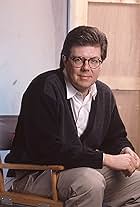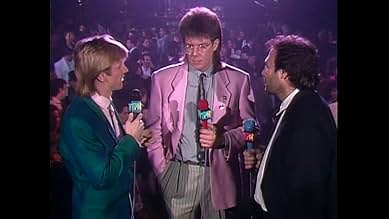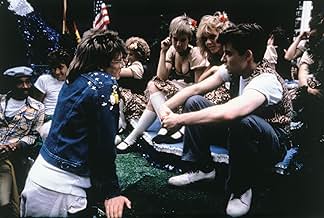John Hughes(1950-2009)
- Writer
- Producer
- Director
John Hughes was an American film director, film producer, and screenwriter. He was credited for creating some of the most memorable comedy films of the 1980s and the 1990s, when he was at the height of his career. He had a talent for writing coming-of-age stories, and for depicting fairly realistic adolescent characters.
In 1950, Hughes was born in Lansing, Michigan. The city's main employers for much of the 20th century were manufacturing plants for automobiles. Lansing housed the headquarters of companies such as Oldsmobile and the REO Motor Car Company. Hughes' father John Hughes Sr. was a salesman, while Hughes' mother Marion Crawford worked as a volunteer for charity organizations.
Hughes had three sisters and no brothers. His family moved often. For most of his childhood, the Hughes family lived in Grosse Pointe, Michigan, a commuter suburb of Metro Detroit. According to an interview of Hughes, he was the only boy in his neighborhood while growing up. He was surrounded by girls and "old people," and there was no boys around for him to befriend. He spend a lot of time alone, and used his active imagination to keep himself entertained.
In 1963, the Hughes family moved to Northbrook, Illinois, a suburb of Chicago. Hughes attended first the Grove Middle School, and then the Glenbrook North High School. His high school experiences reportedly provided inspiration for his teen-themed films of his career. According to interviews with Hughes' friends, Hughes had a poor relationship with his parents who often criticized him.
As an adolescent, Hughes felt the need to escape his problems. He became an avid film fan, as he found that films satisfied his need for escapism. He was a fan of both the Rat Pack (an informal group of actors and singers), and the music group The Beatles.
After graduating high school, Hughes enrolled in the University of Arizona. He eventually dropped out of the University, and tried to make a living as a comedy writer. He wrote jokes for professional comedians, such as Rodney Dangerfield (1921 - 2004) and Joan Rivers (1933 - 2014).
In 1970, Hughes was hired by the advertising company Needham Harper & Steers (1925-1986). That same year, Hughes married his former high school classmate Nancy Ludwig. Hughes worked in the advertising industry for several years. In 1974, Hughes was hired by the advertising agency Leo Burnett Worldwide. This company's most notable clients included the Pillsbury Company, StarKist, Heinz, Green Giant, and Philip Morris.
As a marketing agent, Hughes was assigned to handle Virginia Slims, a brand of cigarettes produced by Philip Morris. The assignment required him to regularly travel to New York City, where Philip Morris' headquarters were located. Hughes took the opportunity to visit the offices of the popular humor magazine "National Lampoon" (1970-1998) in New York City. He successfully negotiated a new position as a regular contributor to the magazine.
Hughes reportedly impressed the magazine's editors by producing quality work at a fast pace. Among his first short stories was "Vacation '58," based on his recollections of his family's vacations during his childhood. The story was eventually adapted into the road comedy film "National Lampoon's Vacation" (1983).
"National Lampoon" co-produced films written by their staff writers. Hughes provided the script for the black comedy "National Lampoon's Class Reunion" (1982), depicting a serial killer who targets his former classmates. The film was poorly received and under-performed at the box office, but it inspired Hughes to try to make a career as a screenwriter.
Hughes subsequently wrote the scripts for both "National Lampoon's Vacation" (1983) and "Mr. Mom" (1983), comedy films which were box office hits. He then signed a contract for three films with the studio Universal Pictures. He made his directing debut in the coming-of-age comedy film "Sixteen Candles" (1984). The film depicted the misadventures of high school sophomore Samantha "Sam" Baker (played by Molly Ringwald). It performed well at the box office, and was well-received by critics.
Hughes quickly established himself as a leading director of teen films. His films "The Breakfast Club" (1985), "Weird Science" (1985), and "Ferris Bueller's Day Off" (1986) are considered classics of the genre. To cover new ground, he then directed "Planes, Trains and Automobiles" (1987), featuring a duo of adult protagonists. The stars of the film were experienced comic actors Steve Martin and John Candy. The film was a hit. More importantly, Hughes and Candy became close friends. They would often work together in subsequent films.
Hughes' next film as a director was "She's Having a Baby" (1988), about the life of a newlywed couple. The film fared poorly financially and was considered rather "blasé" by critics. Hughes made a comeback with "Uncle Buck" (1989), about a lifelong bachelor who has to take care of his two nieces and a nephew. The film was a box office hit, earning about 80 million dollars at the box office.
Hughes' final film as a director was the comedy-drama "Curly Sue" (1991), about homeless con artist Bill Dancer (played by Jim Belushi) who desperately tries to keep the custody of his surrogate daughter. While moderately successful at the box office at the box office, the film was widely ridiculed for being overly sentimental.
In the 1990s, Hughes found success as a screenwriter, scripting several box office hits. Among his most notable films in this period were "Home Alone" (1990) and "Beethoven" (1992), with both films starting lucrative media franchises. Hughes also wrote the scripts of the sequels "Home Alone 2: Lost in New York" (1992) and "Home Alone 3" (1997). He also scripted a notable comic strip adaptation, "Dennis the Menace" (1993). It was based on the long-running comic strip "Dennis the Menace" (1951-) by Hank Ketcham (1920-2001).
In 1994, Hughes moved to the Chicago metropolitan area. At about that time, he started actively avoiding publicity. He rarely gave any interviews until the end of his life. In 1995, Hughes co-founded the production company Great Oaks Entertainment, which mainly handled co-production of Disney produced films. Hughes handled the scripting of two of the company's films: "101 Dalmatians" (1996) and "Flubber" (1997). Both were remakes of older films.
In 1997, Hughes severed his partnership with Ricardo Mestres. A year later, their final co-production, "Reach the Rock," was released. The film was scripted by Hughes, though it was uncharacteristically dramatic for a Hughes film. The film depicted the conflict between an alienated young man and a police chief.
In the 2000s, Hughes only scripted three more films. The most notable among them the romantic drama "Maid in Manhattan" (2002), a hit for protagonist Jennifer Lopez. It earned about 164 million dollars.
In August 2009, Hughes visited New York City with his wife. He wanted to visit one of his sons who lived there, and to meet his new grandson. On August 6, Hughes suffered a heart attack while walking in Manhattan. He was transported to Roosevelt Hospital, but died shortly after. He was fifty-nine years old.
Hughes was buried in Lake Forest Cemetery, a rural cemetery located in Lake Forest, Illinois. He was survived by his wife, their two children, and several grandchildren.
In 1950, Hughes was born in Lansing, Michigan. The city's main employers for much of the 20th century were manufacturing plants for automobiles. Lansing housed the headquarters of companies such as Oldsmobile and the REO Motor Car Company. Hughes' father John Hughes Sr. was a salesman, while Hughes' mother Marion Crawford worked as a volunteer for charity organizations.
Hughes had three sisters and no brothers. His family moved often. For most of his childhood, the Hughes family lived in Grosse Pointe, Michigan, a commuter suburb of Metro Detroit. According to an interview of Hughes, he was the only boy in his neighborhood while growing up. He was surrounded by girls and "old people," and there was no boys around for him to befriend. He spend a lot of time alone, and used his active imagination to keep himself entertained.
In 1963, the Hughes family moved to Northbrook, Illinois, a suburb of Chicago. Hughes attended first the Grove Middle School, and then the Glenbrook North High School. His high school experiences reportedly provided inspiration for his teen-themed films of his career. According to interviews with Hughes' friends, Hughes had a poor relationship with his parents who often criticized him.
As an adolescent, Hughes felt the need to escape his problems. He became an avid film fan, as he found that films satisfied his need for escapism. He was a fan of both the Rat Pack (an informal group of actors and singers), and the music group The Beatles.
After graduating high school, Hughes enrolled in the University of Arizona. He eventually dropped out of the University, and tried to make a living as a comedy writer. He wrote jokes for professional comedians, such as Rodney Dangerfield (1921 - 2004) and Joan Rivers (1933 - 2014).
In 1970, Hughes was hired by the advertising company Needham Harper & Steers (1925-1986). That same year, Hughes married his former high school classmate Nancy Ludwig. Hughes worked in the advertising industry for several years. In 1974, Hughes was hired by the advertising agency Leo Burnett Worldwide. This company's most notable clients included the Pillsbury Company, StarKist, Heinz, Green Giant, and Philip Morris.
As a marketing agent, Hughes was assigned to handle Virginia Slims, a brand of cigarettes produced by Philip Morris. The assignment required him to regularly travel to New York City, where Philip Morris' headquarters were located. Hughes took the opportunity to visit the offices of the popular humor magazine "National Lampoon" (1970-1998) in New York City. He successfully negotiated a new position as a regular contributor to the magazine.
Hughes reportedly impressed the magazine's editors by producing quality work at a fast pace. Among his first short stories was "Vacation '58," based on his recollections of his family's vacations during his childhood. The story was eventually adapted into the road comedy film "National Lampoon's Vacation" (1983).
"National Lampoon" co-produced films written by their staff writers. Hughes provided the script for the black comedy "National Lampoon's Class Reunion" (1982), depicting a serial killer who targets his former classmates. The film was poorly received and under-performed at the box office, but it inspired Hughes to try to make a career as a screenwriter.
Hughes subsequently wrote the scripts for both "National Lampoon's Vacation" (1983) and "Mr. Mom" (1983), comedy films which were box office hits. He then signed a contract for three films with the studio Universal Pictures. He made his directing debut in the coming-of-age comedy film "Sixteen Candles" (1984). The film depicted the misadventures of high school sophomore Samantha "Sam" Baker (played by Molly Ringwald). It performed well at the box office, and was well-received by critics.
Hughes quickly established himself as a leading director of teen films. His films "The Breakfast Club" (1985), "Weird Science" (1985), and "Ferris Bueller's Day Off" (1986) are considered classics of the genre. To cover new ground, he then directed "Planes, Trains and Automobiles" (1987), featuring a duo of adult protagonists. The stars of the film were experienced comic actors Steve Martin and John Candy. The film was a hit. More importantly, Hughes and Candy became close friends. They would often work together in subsequent films.
Hughes' next film as a director was "She's Having a Baby" (1988), about the life of a newlywed couple. The film fared poorly financially and was considered rather "blasé" by critics. Hughes made a comeback with "Uncle Buck" (1989), about a lifelong bachelor who has to take care of his two nieces and a nephew. The film was a box office hit, earning about 80 million dollars at the box office.
Hughes' final film as a director was the comedy-drama "Curly Sue" (1991), about homeless con artist Bill Dancer (played by Jim Belushi) who desperately tries to keep the custody of his surrogate daughter. While moderately successful at the box office at the box office, the film was widely ridiculed for being overly sentimental.
In the 1990s, Hughes found success as a screenwriter, scripting several box office hits. Among his most notable films in this period were "Home Alone" (1990) and "Beethoven" (1992), with both films starting lucrative media franchises. Hughes also wrote the scripts of the sequels "Home Alone 2: Lost in New York" (1992) and "Home Alone 3" (1997). He also scripted a notable comic strip adaptation, "Dennis the Menace" (1993). It was based on the long-running comic strip "Dennis the Menace" (1951-) by Hank Ketcham (1920-2001).
In 1994, Hughes moved to the Chicago metropolitan area. At about that time, he started actively avoiding publicity. He rarely gave any interviews until the end of his life. In 1995, Hughes co-founded the production company Great Oaks Entertainment, which mainly handled co-production of Disney produced films. Hughes handled the scripting of two of the company's films: "101 Dalmatians" (1996) and "Flubber" (1997). Both were remakes of older films.
In 1997, Hughes severed his partnership with Ricardo Mestres. A year later, their final co-production, "Reach the Rock," was released. The film was scripted by Hughes, though it was uncharacteristically dramatic for a Hughes film. The film depicted the conflict between an alienated young man and a police chief.
In the 2000s, Hughes only scripted three more films. The most notable among them the romantic drama "Maid in Manhattan" (2002), a hit for protagonist Jennifer Lopez. It earned about 164 million dollars.
In August 2009, Hughes visited New York City with his wife. He wanted to visit one of his sons who lived there, and to meet his new grandson. On August 6, Hughes suffered a heart attack while walking in Manhattan. He was transported to Roosevelt Hospital, but died shortly after. He was fifty-nine years old.
Hughes was buried in Lake Forest Cemetery, a rural cemetery located in Lake Forest, Illinois. He was survived by his wife, their two children, and several grandchildren.




















































![Planes, Trains and Automobiles [Planes, Trains & Automobiles]](https://m.media-amazon.com/images/M/MV5BMjEyNTkzODA1MV5BMl5BanBnXkFtZTcwNDY3Mzc2MQ@@._V1_QL75_UX500_CR0,59,500,281_.jpg)